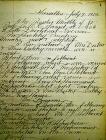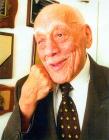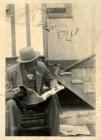1
Minutes dated July 7, 1902, Stewart Memorial Minute Book.1902
Stewart Memorial Church, John St. Hamilton, Ontario, Canada
 Credits:
Credits:Courtesy Stewart Memorial Church
2
After the American Civil War (1861-63) and the Emancipation Proclamation which freed the slaves in the United States, some in the Black community took a return trip on the Underground Railroad. Others remained and the community soldiered on. However, new migration, spurred on by the industrial revolution and the move away from farms, attracted new residents to the city by the bay.7
Ray Lewis (1910-2003) 1932 Olympic bronze medallist.2003
Hamilton, Ontario, Canada
 Credits:
Credits:Courtesy of Stewart Memorial Church
8
Hamilton drew partly from the small town and rural areas of Ontario. Ray Lewis, known for his 1932 Olympic bronze medal achievement in the 4x100 relay in Los Angeles, was born in Hamilton on October 8, 1910. His mother, Emma Green, was born in Collingwood, Ontario, one of the areas settled by former African American slaves. She moved to Guelph where she was working as a maid when she met Ray's father, Cornelius. He had moved to Hamilton from Simcoe, Ontario. Although Cornelius was a skilled builder, the racism of the day dictated that he worked as a dining car waiter on the Grand Trunk Railway and later a janitor at Westinghouse and Canadian PorcelainCompanies.
10
Other families came to Hamilton from the United States at the turn of the century. One family who arrived from the United States was that of Shirley (Wade) Brown. Shirley's mother and grandmother, Evangeline Day and Mary Ellen (Logan) Day came to Canada from Danville, Virginia in approximately 1900."…My grandmother had asthma very bad, and my grandfather burned the tobacco and [his employer] sent him to Canada [where] he worked at Tuckett's [Tobacco Factory]. But the weather was better for my grandmother. My mother was only between five and seven when she came to Canada."
11
Shirley's father, Byron Kenton Wade, was born on an Indian Reservation near St. Paul, Minnesota and came to Canada as a boy with his father - Reverend George Harrison Wade. Between 1910-12, Reverend Wade pastored at St. Paul's AME. Byron Kenton Wade became a vaudeville entertainer who sang, danced and played the guitar and banjo. He married Evangeline Day when the two were quite young. They had seven children but eventually the marriage dissolved. Both Mrs. Wade and her mother supported the family doing housework and Mrs. Wade later worked as a matron at the Tivoli and Century Theatres. These were the types of jobs available to many Black women prior to World War II."She looked after the washrooms and made sure that there was no one there bothering any of the kids or anything. She used to walk up and down the aisle, … and when they were really busy, she used to be an usher and used to sit people in their seats. And that's how she made her living, and then she finally retired from the Century Theatre. But that's how her and my grandmother raised us, between my grandmother doing housework too, because she retired from Tuckett's but she would still go out and do housework…"
12
Lois Wade (Gaskin) at the Port Dalhousie in August 1941.August, 1941
Port Dalhousie, Ontario, Canada






